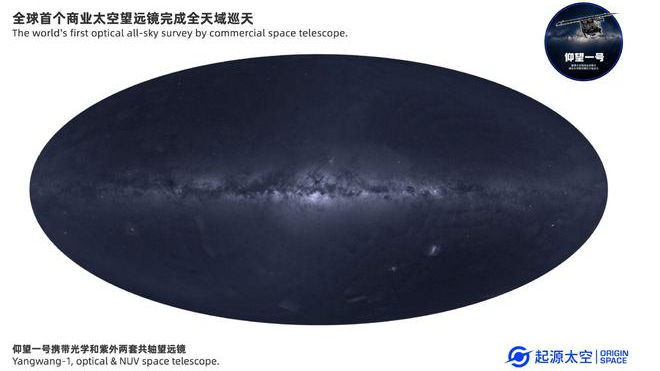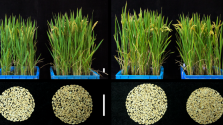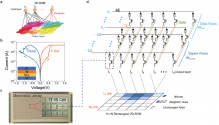You are using an out of date browser. It may not display this or other websites correctly.
You should upgrade or use an alternative browser.
You should upgrade or use an alternative browser.
News on China's scientific and technological development.
- Thread starter Quickie
- Start date
As long as GMO crops are properly tested for human to consume and for use as animal feed, they are fine.
The worst is that company like Monsato, insert kill gene into their GMO seeds, so after harvest, farmers can't reuse what they harvested for seed for the next growing cycle, like our ancestors did for Millennium. That force the farmers to keep buying new seeds from those company forever as long as they farm. And farmers are paying heft premium on loyalties on the seeds for ever.
If you want to look up 'Gold rice', it has no loyalty on it for any farmer want to grow it, then again, that's done by a non-profit organization, not one of those western 'biotech' companies.
The worst is that company like Monsato, insert kill gene into their GMO seeds, so after harvest, farmers can't reuse what they harvested for seed for the next growing cycle, like our ancestors did for Millennium. That force the farmers to keep buying new seeds from those company forever as long as they farm. And farmers are paying heft premium on loyalties on the seeds for ever.
If you want to look up 'Gold rice', it has no loyalty on it for any farmer want to grow it, then again, that's done by a non-profit organization, not one of those western 'biotech' companies.
AssassinsMace
Lieutenant General
Unless there’s a specific enzyme or protein that’s created that’s toxic to human consumption all that stuff is going to get digested the same way. And all the new proteins and other organic compounds that are being produced through the genetic modification are things that already exist in some natural form somewhere else. So it’s not like we’re in the dark about potential toxicity from GMO modifications.Call me skeptical, but I would prefer to stay away from genetically modified crops. I get organic when possible.
China accomplishes world's 1st optical all-sky survey by commercial telescope

China's commercial space telescope Yangwang-1 completes an optical survey of the whole sky. /Origin Space
China's commercial space telescope Yangwang-1 completed an optical survey of the whole sky, according to its developer Origin Space, marking the world's first optical survey using a commercial space telescope.
The telescope, launched into orbit from the Taiyuan Satellite Launch Center in north China's Shanxi Province on June 11, 2021, was developed by Shenzhen-based Origin Space Technology Co., Ltd. for asteroid resource exploration and research.
Su Meng, the founder and CEO of Origin Space, said during its stay in orbit, Yangwang-1 carried out sky survey observation, atmospheric luminous observation, night remote monitoring and asteroid observation.
In addition to its astronomical, asteroid and space debris observation capabilities, Yangwang-1 can also perform nighttime remote sensing, and the spatial resolution of the nighttime light satellite images obtained has reached less than 30 meters, said Su.
Origin Space plans to build a constellation in the future, which will be composed of multiple multi-band space telescopes. The first phase of the network with 10 satellites is expected to be completed in 2023, Su said.

Chinese scientists have found two genes in rice that can make the staple crop more heat-resistant, providing a new way to breed highly thermotolerant crops, according to a study published in the journal Science.
The researchers from the Shanghai Institute of Plant Physiology and Ecology under the Chinese Academy of Sciences and Shanghai Jiao Tong University revealed the mechanism by which the rice's cell membrane senses external heat-stress signals before communicating with chloroplasts – the organelles in which photosynthesis occurs.
Too much heat can damage a plant's chloroplasts. When temperatures exceed a crop's usual tolerance, its yields tend to drop.
The researchers identified a locus with two genes: Thermo-tolerance 3.1 (TT3.1) and Thermo-tolerance 3.2 (TT3.2). They interact in concert to enhance rice thermotolerance and reduce grain-yield losses caused by heat stress.
The researchers found that accumulated TT3.2 triggers chloroplast damage regarding heat stress, but, in that scenario, TT3.1 can serve as a remedy.
Upon heat stress, TT3.1, a potential thermosensor, will remove the cell membrane from the cell to degrade the mature TT3.2 proteins, according to the study.
"The study elucidates a fresh molecular mechanism that links plant cell membranes with the chloroplast in responding to heating signals," said the paper's co-corresponding author Lin Hongxuan with the Shanghai Institute of Plant Physiology and Ecology.
Then, the researchers used hybridization to translate the TT3 locus of African rice into Asian species.
The field test has shown that the new species is more heat tolerant. It can withstand heat at 38 degrees Celsius without crop failure, while the output of normal species would be reduced above 35 degrees Celsius, said the researchers.
The newly-found gene might also be used in other plants, including wheat, maize, bean, and vegetables, to cultivate heat-tolerant strains, according to the researchers.
The Self-Organizing Map Network ( SOM , Figure 1a ), also known as the “Kohone network ” , is a powerful unsupervised learning neural network inspired by the topology of the brain. Compared with linear algorithms such as classical multi-dimensional scaling or principal component analysis, SOM has more powerful data clustering capabilities and exhibits unique advantages in clustering and optimization problems such as language recognition, text mining, financial forecasting, and medical diagnosis. However, the implementation of SOM based on traditional CMOS hardware is limited by the complexity of calculating similarity and determining the neighborhood, and has problems such as complex circuit structure, high energy area overhead, and lack of accurate calculation of similarity. How to build concise, efficient, and accurate SOM hardware is still a big challenge. As a new type of programmable non-volatile memory device, memristor has the natural advantage of supporting parallel computing and in-memory computing with its interleaved array structure, which provides a new way for the hardware implementation of SOM .
Recently, the team of Academician Liu Ming from the Institute of Microelectronics and the team of Professor Liu Qi from Fudan University used memristor arrays (Fig. 1b & c ) to construct the weight matrix in the SOM network, realizing an efficient SOM hardware system for the first time. To address the increased hardware system complexity when the number of neurons and input features in the SOM increases, the team proposes a novel multi-additional row memristor array architecture (Fig. 1d ), which divides the memristor array into two One part stores weight information as data rows, and the other part stores the sum of squares of weights as additional rows. The similarity between the input vector and the weight vector can be achieved with one-step read operation without the need to normalize the weights. Based on this hardware system, the team successfully demonstrated data clustering, image segmentation, image compression and other applications and successfully used it to solve combinatorial optimization problems (Figure 2 ). Experimental results show that the system has higher energy efficiency and computational throughput than CMOS systems without compromising success rate or accuracy . In addition, due to its unsupervised characteristics, the application scenarios are richer and more suitable for the needs of real life, opening up a new way for the construction of memristor-based intelligent hardware.
The research was supported by the National Key R&D Program, the National Natural Science Foundation of China, the National Major Science and Technology Project, and the Zhejiang Provincial Key Scientific Research Project. The research results were published online in Nature Communications under the title " Implementing in-situ Self-organizing Maps with Memristor Crossbar Arrays for Data Mining and Optimization " . Dr. Wang Rui from the Institute of Microelectronics is the first author, and researcher Liu Qi, a professor at the Institute of Chip and System Frontier Technology, Fudan University, and Shi Tuo, an associate researcher from the Institute of Microelectronics, are the co-corresponding authors.
The research was supported by the National Key R&D Program, the National Natural Science Foundation of China, the National Major Science and Technology Project, and the Zhejiang Provincial Key Scientific Research Project. The research results were published online in Nature Communications under the title " Implementing in-situ Self-organizing Maps with Memristor Crossbar Arrays for Data Mining and Optimization " . Dr. Wang Rui from the Institute of Microelectronics is the first author, and researcher Liu Qi, a professor at the Institute of Chip and System Frontier Technology, Fudan University, and Shi Tuo, an associate researcher from the Institute of Microelectronics, are the co-corresponding authors.

Fig. 1 SOM schematic and its implementation based on memristor array. (a) Schematic of the SOM network. (b) Typical IV curve of a memristor . (c) Optical physical image of the 128×64 1T1R memristor array. (d) Schematic diagram of the 1T1R memristor array realizing 2D-SOM .
Not a News on China's S&T Development, but since it was related to earlier discussion on this thread, so here goes.
After a 2 year-gap lost to Japan's Fugaku, the US can finally brag about having the fastest supercomputer yet again!
Quoting this particular opening sentence from that article:
"ONLY MACHINE IN THE WORLD"
"EXAFLOP"
China with two Exascale supercomputers already & (kind of) secretly in operation way back in 2020/2021 (plus a 3rd one incoming) be like:

After a 2 year-gap lost to Japan's Fugaku, the US can finally brag about having the fastest supercomputer yet again!
Quoting this particular opening sentence from that article:
(Frontier) It's the only machine in the world that has ever demonstrated that it could perform more than one quintillion (that's 1,000,000,000,000,000,000) calculations per second. In the language of computer science, that's called an exaflop.
"ONLY MACHINE IN THE WORLD"
"EXAFLOP"
China with two Exascale supercomputers already & (kind of) secretly in operation way back in 2020/2021 (plus a 3rd one incoming) be like:

Last edited:
Chinese mathematicians and astronomers worked together to find solutions to the famous three-body problem.
Published paper in English:
News report in Chinese:
Published paper in English:
Three-body problem — From Newton to supercomputer plus machine learning
The famous three-body problem can be traced back to Newton in 1687, but quite few families of periodic orbits
were found in 300 years thereafter. In this paper, we propose an effective approach and roadmap to numerically
gain planar periodic orbits of three-body systems with arbitrary masses by means of machine learning based on
an artificial neural network (ANN) model. Given any a known periodic orbit as a starting point, this approach
can provide more and more periodic orbits (of the same family name) with variable masses, while the mass
domain having periodic orbits becomes larger and larger, and the ANN model becomes wiser and wiser. Finally
we have an ANN model trained by means of all obtained periodic orbits of the same family, which provides
a convenient way to give accurate enough predictions of periodic orbits with arbitrary masses for physicists
and astronomers. It suggests that the high-performance computer and artificial intelligence (including machine
learning) should be the key to gain periodic orbits of the famous three-body problem.
News report in Chinese:
中国科学家们也一直在探索“三体问题”的奥秘。2009年,上海交通大学廖世俊提出一个获得混沌动力系统收敛轨迹的策略——精准数值模拟(Clean Numerical Simulation),简称CNS。CNS能将数值误差降到任意小,从而可获得混沌系统足够长时间内收敛的数值解,在理论上为准确获得“三体问题”的周期轨道铺平了道路。
基于CNS,2017年廖世俊团队成功获得等质量的“三体问题”695类周期轨道;2018年廖世俊团队与上海交通大学物理和天文学院景益鹏院士合作,应用CNS进一步成功获得两个质量相等的三体系统1349类全新的周期轨道。
任意不等质量的三体系统之周期轨道的获取更为困难。2021年廖世俊与暨南大学李晓明等合作,以一个已知的、具有相同质量的三体系统周期轨道为基础,成功应用CNS获得该三体系统任意不等质量的135445个周期轨道,将“三体问题”周期轨道数量增加了几个数量级,证实了CNS求解任意质量“三体问题”周期轨道(特别是长周期轨道)的有效性。
2022年,为了进一步大幅提高计算效率,廖世俊、李晓明、杨宇将CNS结合机器学习(一种从数据中分析获得规律,并利用该规律对未知数据进行预测的算法),提出了一个获得“三体问题”周期轨道的路线图。从用传统方法获得的、很小质量范围内的周期轨道出发,基于机器学习和CNS一步步地获得更大质量范围内的精确周期轨道,直至找到该类周期轨道中所有不同质量的精确周期轨道。
“三体问题”的解决,本质上依赖高性能计算机和数学方法。廖世俊等基于CNS和机器学习提出求解“三体问题”周期轨道之路线图,将计算效率提高了几个数量级,为获得“三体问题”海量的、精确的周期轨道铺平了道路。“三体问题”周期轨道的求解,证实了CNS求解复杂混沌问题的有效性和潜力。理论上,CNS可应用于N体问题周期轨道的求解以及湍流研究等,为星系演化、复杂湍流的精确数值模拟等提供了一个全新的研究工具。
该论文2022年在国际天文学杂志《》上发,其相关机器学习程序和周期轨道可在 免费下载。
